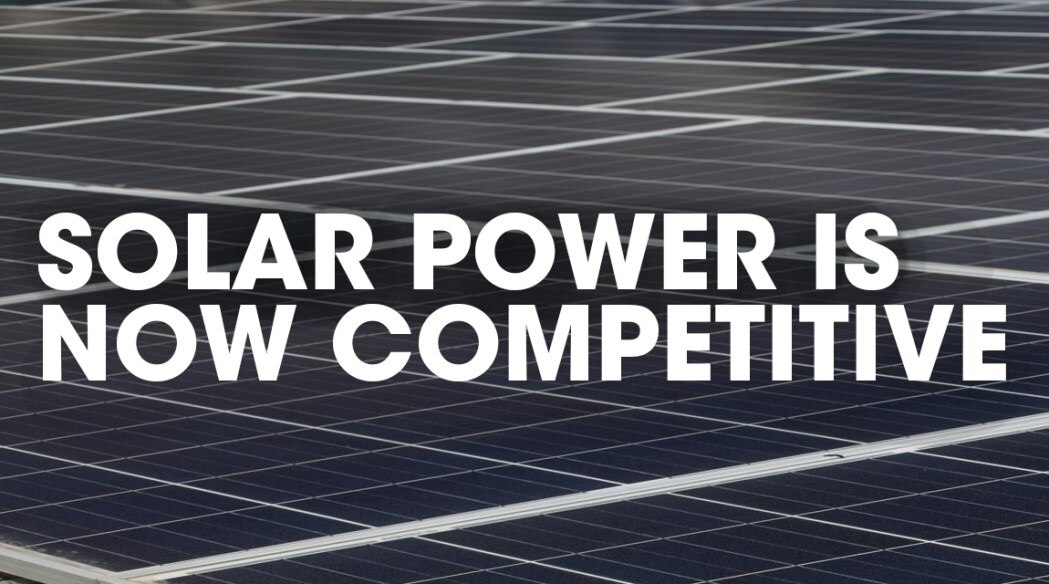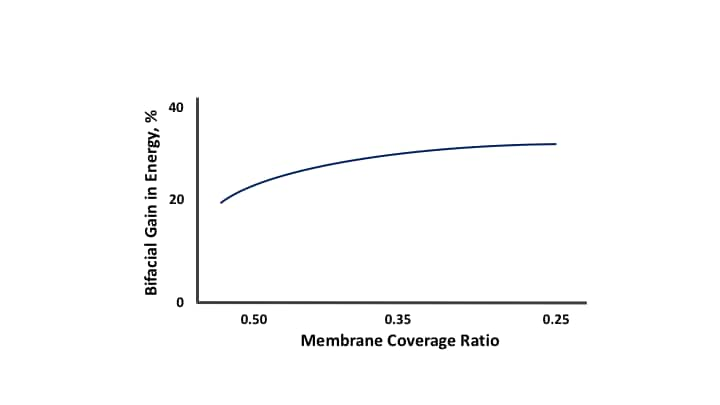For Commercial Roofing, Careful Design and Material Choices Can Make Solar Compelling
Each energy production type, such as coal and solar, has a range of costs depending on location, the efficiency of the particular equipment used, etc. Today the range of costs of photovoltaic — or solar —power now overlap those of conventional sources of electricity as shown in the following graphic (2021 data courtesy of Lazard).

To better compare true costs, the data shown above does not include any tax or other subsidies. The term "Levelized Cost" is defined as an economic assessment of the average total cost to build and operate a power-generating asset over its lifetime divided by the total energy output of the asset over that lifetime. It includes initial capital, as well as maintenance, operating, and fuel costs. It is the breakeven cost without any margins for profit.
An immediate conclusion from the chart is that solar energy, especially utility scale and commercial and industrial roof installations, is competitive with conventional power generation. For the remainder of this article, solar on commercial and industrial roofs ("solar C & I") will be examined more closely.
The power cost of solar C & I varies between $85 and $194 per megawatt hour, or MWh. The design and engineering of such rooftop solar arrays are now highly specialized with a focus on increasing performance (i.e., output or production) and lowering costs. A key metric is the energy density, or energy production per unit area, which will be examined in detail here together with the expected productive life of such installations. Energy density and overall life cycle are important drivers of levelized cost. Some specific parameters vary depending on whether an array is comprised of standard solar panels or bifacial panels. These are discussed separately.
Standard Solar Modules
Maximizing Energy Density
The array design plays a key role in determining energy density. For maximum power production per panel, the array orientation is directly perpendicular to the sun's energy. This results from having south-facing panels angled at 30° (for southern US locations) as shown here:

However, this arrangement doesn't maximize the number of panels that can be mounted in a given area. In other words, the energy density isn't maximized. The following schematic shows the panels closer together, but at a less optimum angle to the sun. The panels are at a lower angle to avoid shading and so there is a trade-off between maximizing power from each individual panel versus that of the entire installation.
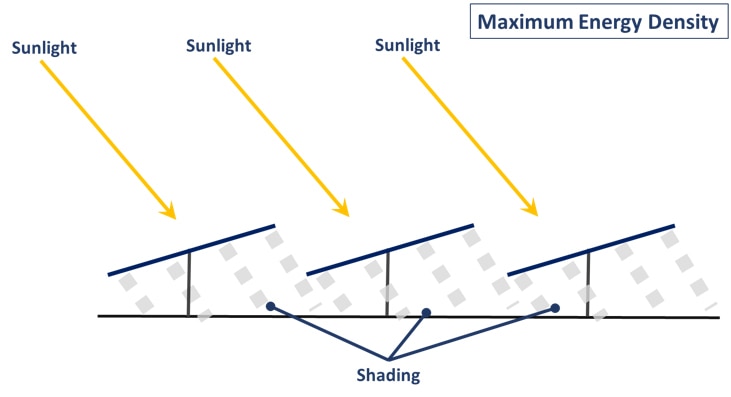
Of course, the sun's angle changes with location, time of day and throughout the year. However, solar system designers now model an array's output to maximize the annualized energy density for each specific location.
The Daily Energy Curve
If an array is oriented directly south, then power output would rise during the day as the sun rose in the sky. Peak power would be produced between noon and 1pm when the sun is most directly overhead, after which it would taper off. This might seem optimal but there are two situations that could change that perspective:
- Some utility companies prefer that solar arrays be designed to produce peak power closer to mid-afternoon, to coincide with peak power demand due to air conditioning loads. In such cases, solar arrays are oriented slightly westerly so that the sun is more perpendicular to the panels in mid-afternoon.
- Solar C&I installations are sometimes made with the express intention of supplying as much of a building's power as possible. In such cases, it might be desirable to smooth out the power curve so that power is provided more uniformly throughout the day. This is done by arranging the panels in a so-called east-west orientation, shown in the following schematic:
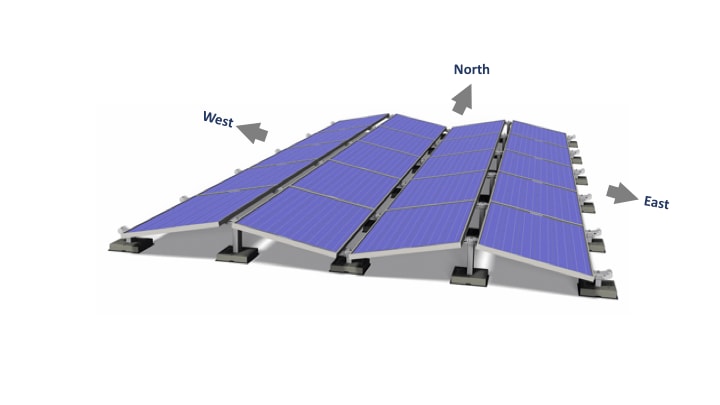
Daily energy output from such a configuration, compared to that of a more conventional south facing array is shown in the following plot:

Examination of the east-west panel arrangement suggests that energy density, while not maximized, could be fairly high. Such an installation essentially avoids shading except around sunrise and sunset.
Solar Array Lifetime Assumption
As described earlier, levelized cost calculations assume a certain lifetime during which the asset will produce power. In the case of the data shown in the initial graph, solar arrays were assumed to have a twenty year lifespan. There is some evidence that most solar panel failures occur during the initial years of operation, as manufacturing defects and the like cause breakdowns. However, once those few defective panels have been replaced, there is significant anecdotal evidence that arrays can produce useful power for several decades.
Inverters, which are necessary to convert an array's direct current to alternating current, may also experience initial failures due to manufacturing and wiring defects. Inverters may also experience longer-term failures, but as inverter costs continue to fall, replacement/repair of these devices becomes part of regular system maintenance.
Roof membrane life can be a significant factor in determining the long term economic life of a solar C & I installation. If the membrane requires replacement, the cost of removing and then re-installing the array could prove to be prohibitive. GAF EverGuard Extreme® TPO was developed for demanding installations and for those situations where a longer roof service life was desired. With guarantee coverage available up to 35 years (depending on installation method and membrane thickness) and exceptional accelerated weathering performance, the long term risk of failure is lower for GAF EverGuard Extreme® TPO than for other TPO membranes.
Bifacial Solar Modules
So far, this blog has been focused on conventional solar panels. However, bifacial solar panels could provide more power than standard modules and are growing in popularity. However, bifacial modules change some of the considerations we've been discussing. Bifacial solar panels are able to absorb solar energy from both sides, with the general concept shown here:
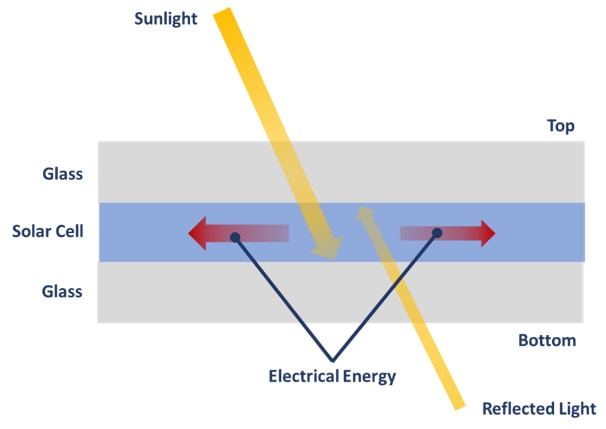
Bifacial panels should be installed above highly reflective surfaces, as shown here:
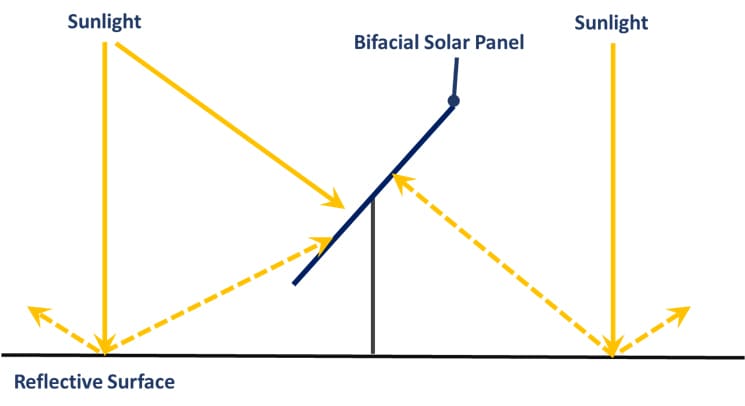
It is important to ensure that the underlying substrate is not shaded too much. In fact, bifacial modules require a different set of considerations to maximize power density as compared to the conventional panels discussed above. There are three factors that can increase the energy production of a bifacial installation: the module height above the membrane, the tilt angle, and module row-to-row spacing.
Bifacial Module Height
Module height is important because of its relationship with shading of the membrane. As the following schematic suggests, modules that are further above a highly reflective membrane will produce more energy than those closer.
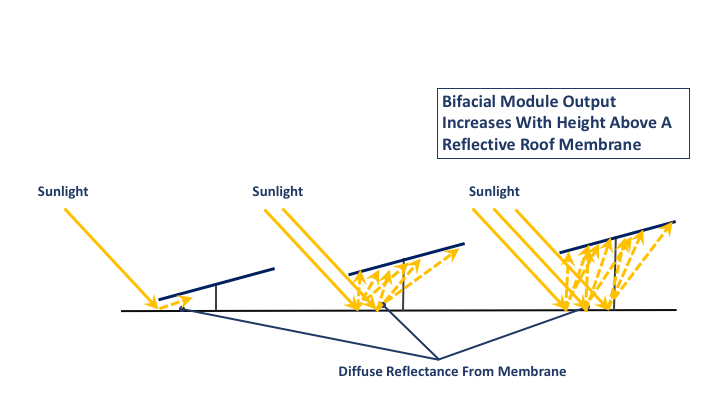
Design guidelines such as those provided by LG* and Prism* suggest the following relationship between height, measured to the lowest point, and bifacial energy gain.

The array designer will need to balance factors like wind resistance and cost against the potential energy gain. In most situations, it would be wise to keep the modules at or below the parapet wall height to minimize wind loads.
Bifacial Tilt Angle and Row Spacing
As with standard modules, the tilt angle of bifacial panels can be increased to maximize energy density, but membrane coverage must be considered. This is best explained by referring to the following schematic.

Standard module rows can be closely spaced, with the limiting factor being the degree of shading of the modules themselves. With bifacial modules, shading of the membrane is the limiting factor. As with module height, the bifacial gain in energy can be modeled as a function of membrane coverage ratio. The following graphic shows a generalized response for a bifacial module with a high rear side efficiency:
Membrane Reflectivity
As stated earlier, the output of bifacial solar panels is dependent on the reflectivity of the substrate. In the case of TPO single ply roofing membranes, there are generally only minor differences between TPO membranes from different manufacturers in terms of initial reflectance. The critical measure is solar reflectance since it is visible light that provides energy for conversion to electricity. Solar Reflectance Index, or SRI, is not appropriate because it includes an emittance term which is a measure of heat being radiated from the surface.
The independent Cool Roof Rating Council shows GAF EverGuard® TPO to have an initial reflectivity of 0.76, in line with other standard TPO membranes. The three year aged reflectivity is shown as 0.68, again in line with other TPO membranes. However, GAF EverGuard Extreme® has an initial reflectivity of 0.83, i.e., 7 percentage points higher than the standard TPO. The three-year aged value is stated to be 0.72.
Many in the solar industry use albedo as a measure of reflectance, instead of solar reflectance used by the roofing industry. In practice, the two measures are very similar, with albedo being a total spectrum reflectance while solar reflectance is primarily measured across the visible region of the sun's energy. The following chart shows the bifacial energy gain as a function of roof albedo, using data from LG*.
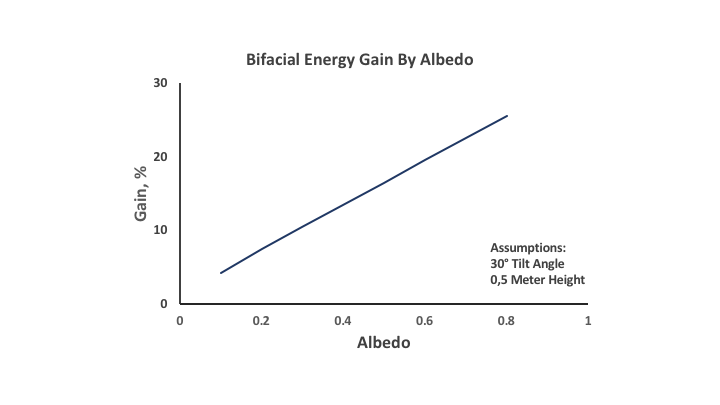
Clearly, high albedo or solar reflectance increases the energy output from bifacial modules in a solar C&I application. It is thus beneficial to have a membrane like GAF EverGuard Extreme® TPO, which has the potential to maintain a high reflectance. As discussed in the previous blog, TPO generally can maintain a higher level of reflectance versus other membrane types, but also GAF EverGuard Extreme® TPO in particular could resist dirt pick-up for a longer time than other TPO membranes.
Solar Array Lifetime Assumption
For bifacial module installations, membrane life is as important as for standard solar modules, i.e., a long system life can lower the levelized cost of energy. This can then contribute to levelized costs that are more competitive versus conventional energy sources.
Summary
- Solar energy costs are now very competitive with respect to conventional energy sources such as coal and gas-powered generation.
- Optimization of the levelized cost of solar power is key to making such power a compelling choice.
- Maximizing energy density from solar C&I installations, although somewhat different for standard solar modules versus bifacial modules, is an important factor in lowering overall energy costs.
- Roof membrane choice is important for two reasons:
- Membranes like GAF EverGuard Extreme® TPO provide a longer service life than standard TPO membranes, which can reduce or eliminate costs of removal and reinstallation of the solar array associated with roof replacement
- The high reflectivity and possible long term maintenance of that reflectivity makes GAF EverGuard Extreme® TPO a compelling choice for bifacial module installations. This is due to the bifacial energy gain resulting from higher albedo substrates.
*Trade and company names or company products referred to herein are intended only to describe the materials and products discussed. In no case do these references imply recommendation or endorsement, nor do they imply that the particular products are the best available for the purpose discussed.
